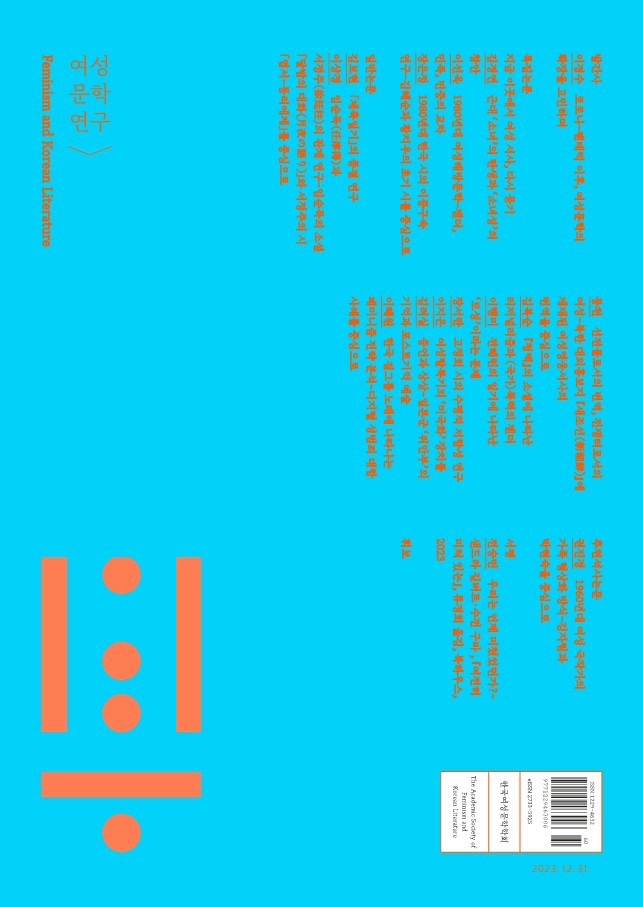- KOREAN
- P-ISSN1229-4632
- E-ISSN2733-5925
- KCI
 ISSN : 1229-4632
ISSN : 1229-4632
Article Contents
- 2024 (No.61)
- 2023 (No.58)
- 2022 (No.55)
- 2021 (No.52)
- 2020 (No.49)
- 2019 (No.46)
- 2018 (No.43)
- 2017 (No.40)
- 2016 (No.37)
- 2015 (No.34)
- 2014 (No.31)
- 2013 (No.29)
- 2012 (No.27)
- 2011 (No.25)
- 2010 (Vol.23)
- 2009 (Vol.21)
- 2008 (Vol.19)
- 2007 (No.17)
- 2006 (No.15)
- 2005 (No.13)
- 2004 (No.11)
- 2003 (No.9)
- 2002 (No.7)
- 2001 (No.5)
- 2000 (No.3)
- 1999 (No.1)
Women’s Labor and Class : Beginning of Alive Days and Standing Woman by Park Wansuh
Abstract
This paper examines the representation of middle class women’s labor and social class in Park Wansuh’s novels The Beginning of Alive Days and Standing Woman. In so doing, I incorporate Marxist feminist theory to explore the principle of the capitalist system which operates by exploiting not only wage labor but also un-waged reproductive labor. Although the women characters in the two novels are high in social status, they are not free from the exploitation of their reproductive labor in the private sphere by their husbands, thus explaining why the women conflict with other characters and the broader society. This article proposes that this phenomenon exemplifies the “the woman question,” and addresses how the two novels depict the material foundation of society. Park Wansuh’s novels thereby propose how women may resist the sexist stereotypes which they have internalized. In this process, Park’s novels do not directly challenge family gender inequality or the prejudice against divorced women. Neither is the discrimination of economic status explicitly criticized in the novels. Therefore, on one hand, Park’s novels seem to be conservative, but on the other hand, they visualize women’s social status as a class of reproductive laborers entangled in a controversy over reproductive work.
- keywords
- 박완서, 살아있는 날의 시작, 서있는 여자, 여성문제, 재생산 노동, 중산층, 계급, 노동, Park Wansuh, The Beginning of Alive Days, Standing Woman, Women Questions, Reproductive Labor, Middle Class, Class, Labor
Reference
박완서, 『서있는 여자의 갈등』, 나남, 1986.
박완서, 『서있는 여자』, 세계사, 2003.
박완서, 『살아있는 날의 시작』, 세계사, 2002.
또 하나의 문화, 『여성 해방의 문학?』, 평민사, 1987, 14-29쪽.
전경옥·변신원·김은정·이명실, 『한국여성문화사2: 1945-1980』, 숙명여자대학교 아시아여성연구소, 2005, 124-152쪽.
정진성·안진 외, 『한국현대여성사』, 한울아카데미, 2004, 95-119쪽.
정진희 엮음, 『마르크스주의자들의 여성해방론: 콜론타이·체트킨·레닌·트로츠키 저작선』, 책갈피, 2015, 76-98, 208-228쪽.
앤서니 기든스, 배은경·황정미 역, 『현대사회의 성·사랑·에로티시즘』, 새물결, 2003, 81-88쪽.
프리드리히 엥겔스, 김대웅 역, 『가족, 사유재산, 국가의 기원』, 두레, 2012, 111-112쪽
레오뽈디나 포르투나띠, 윤수종 역, 『재생산의 비밀』, 박종철출판사, 1997, 22-57, 195-197쪽.
실비아 페데리치, 황성원 역, 『혁명의 영점: 가사노동, 재생산, 여성주의 투쟁』, 갈무리, 2013, 21-74쪽.
김양선, 「박완서 소설의 대중성 연구-1980년대 여성문제 소설 다시 읽기」, 『한국문학이론과 비평』 54, 한국문학이론과비평학회, 2012, 215-234쪽.
김정현, 「저소득 이혼여성의 빈곤화 과정: 가족제도와 노동시장에서의 사회적 배제 경험을 중심으로」, 『한국가족복지학』38, 한국가족사회복지학회, 2012, 69-102쪽.
오자은, 「박완서 소설에 나타난 중산층의 정체성 형상화 연구」, 서울대학교 박사학위논문, 2017, 49-60쪽.
이명호·김희숙·김양선, 「여성해방문학론에서 본 80년대의 문학」, 『창작과비평』 18(1), 창작과비평사, 1990, 48-74쪽.
이상록, 「1980년대 중산층 담론과 호모 에코노미쿠스의 확산」, 『사학연구』 130, 한국사학회, 2018, 275-334쪽.
- Downloaded
- Viewed
- 0KCI Citations
- 0WOS Citations
